Introduction
This document describes how to implement Transmission Control Protocol (TCP) State Bypass feature on Firepower Threat Defense (FTD) appliances via Firepower Management Center (FMC) using FlexConfig Policy in versions previous to 6.3.0.
Prerequisites
Requirements
Cisco recommends that you have knowledge of these topics:
- Knowledge of Firepower Management Center.
- Basic Knowledge of Firepower Threat Defense.
- Understanding of the TCP State Bypass feature.
Components Used
The information in this document is based on these software and hardware versions:
- Firepower Threat Defense (FTD) version 6.2.3.
- Firepower Management Center (FMC) version 6.2.3.
Background Information
TCP State Bypass is a feature inherited from the Adaptive Security Appliance (ASA) and provides assistance when troubleshooting traffic that could be dropped by either TCP normalization features, asymmetric routing conditions, and certain Application Inspections.
This feature is natively supported on FMC starting version 6.3.0. It is recommended to delete the Flexconfig objects after the upgrade and move this configuration to the FMC prior to the first deployment. For more information on how to configure TCP State Bypass in version 6.3.0 or later, go to this configuration guide.
Firepower Threat Defense uses ASA configuration commands to implement some features, but not all features. There is no unique set of Firepower Threat Defense configuration commands. Instead, the point of FlexConfig is to allow you to configure features that are not yet directly supported through Firepower Management Center policies and settings.
Note: TCP State Bypass should only be used for troubleshooting purposes or when asymmetric routing cannot be resolved. The use of this feature disables multiple security features and can cause high number of connections if it is not properly implemented.
In order to know more about TCP State Bypass feature or its implementation in ASA, refer to Configure the TCP State Bypass Feature on the ASA 5500 Series and the Cisco ASA 5500 Series Configuration Guide.
Configuration
This section describes how to configure TCP State Bypass on FMC through a FlexConfig Policy.
Step 1. Configure an Extended Access List Object
In order to create an Extended Access List on FMC, go to Objects >Object Management and on the left menu, under Access List select Extended. ClickAdd Extended Access List.
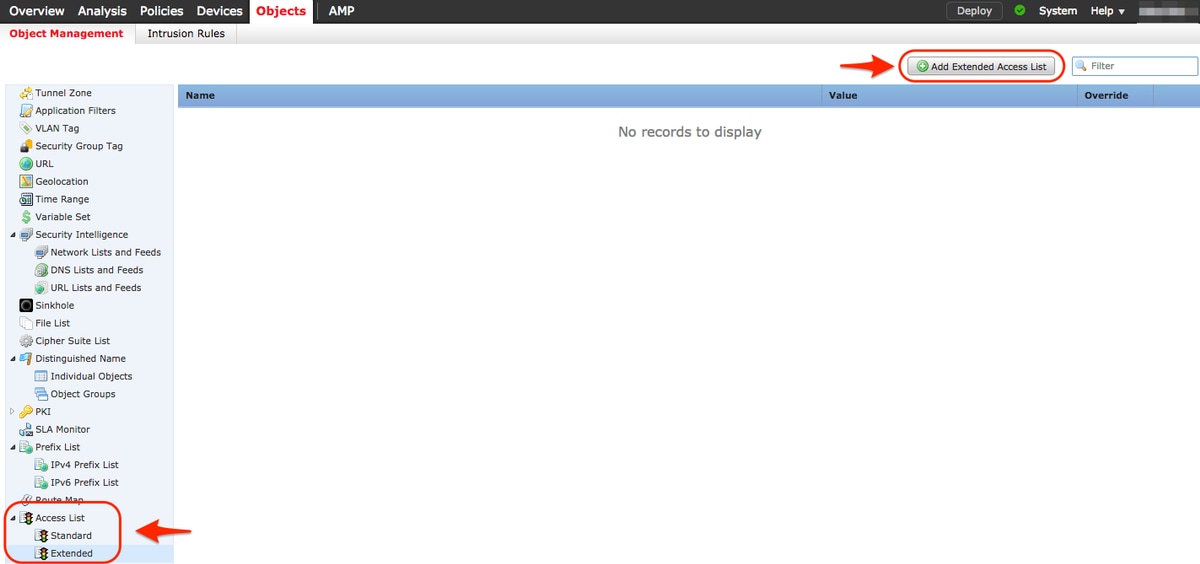
Fill the Name field with the desired value. in this example, the name is TCP_Bypass. Click Add button.
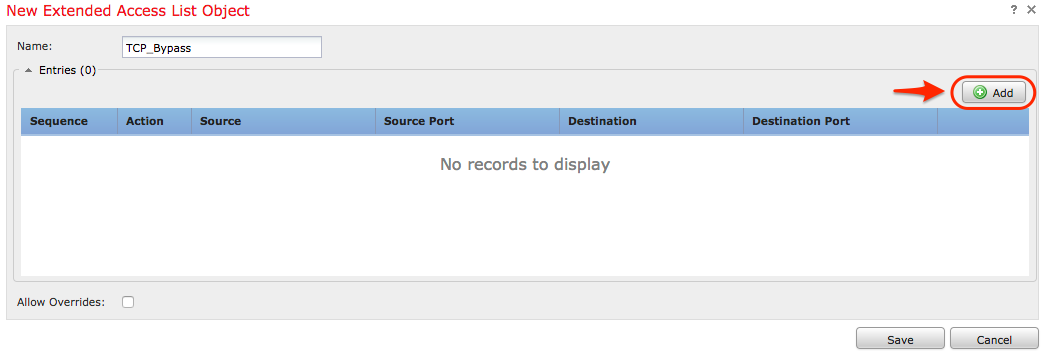
The action for this rule must be configured as Allow. A system defined network can be used or a new network object can be created for each source and destination. In this example, the Access List matches IP traffic from Host1 to Host2 as this is the communication to apply TCP State Bypass. Port tab can optionally be used to match a specific TCP or UDP port. Click on the Add button to continue.
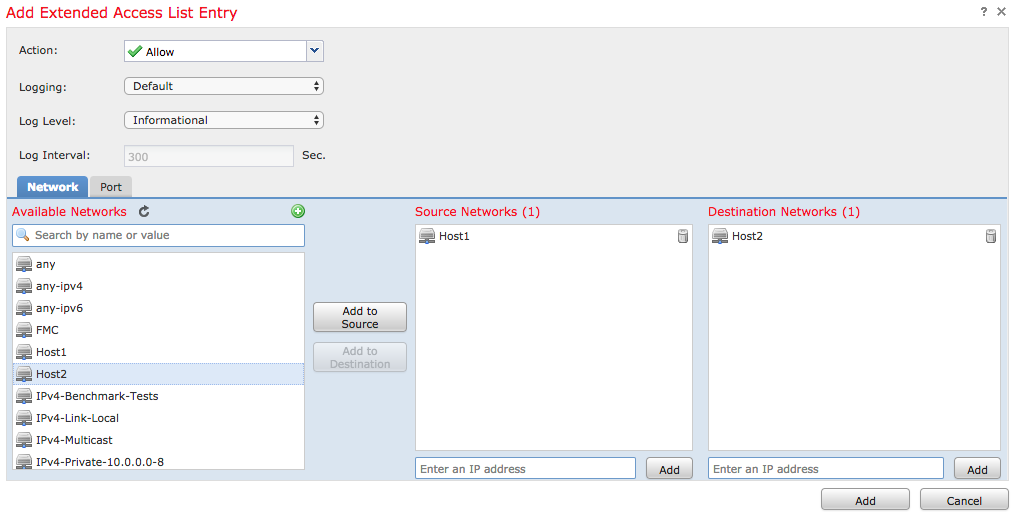
Once the source and destination networks or hosts are selected, click on Save.
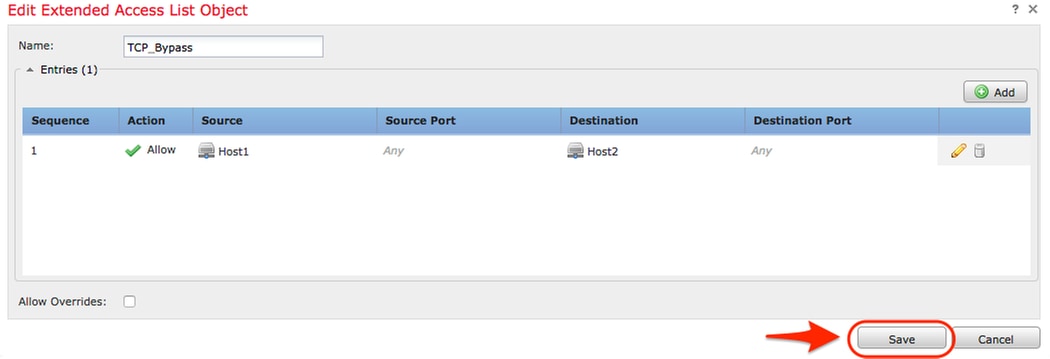
Step 2. Configure a FlexConfig Object
Navigate to Objects > Object Management > FlexConfig > FlexConfig Object and click on Add FlexConfig Object button.
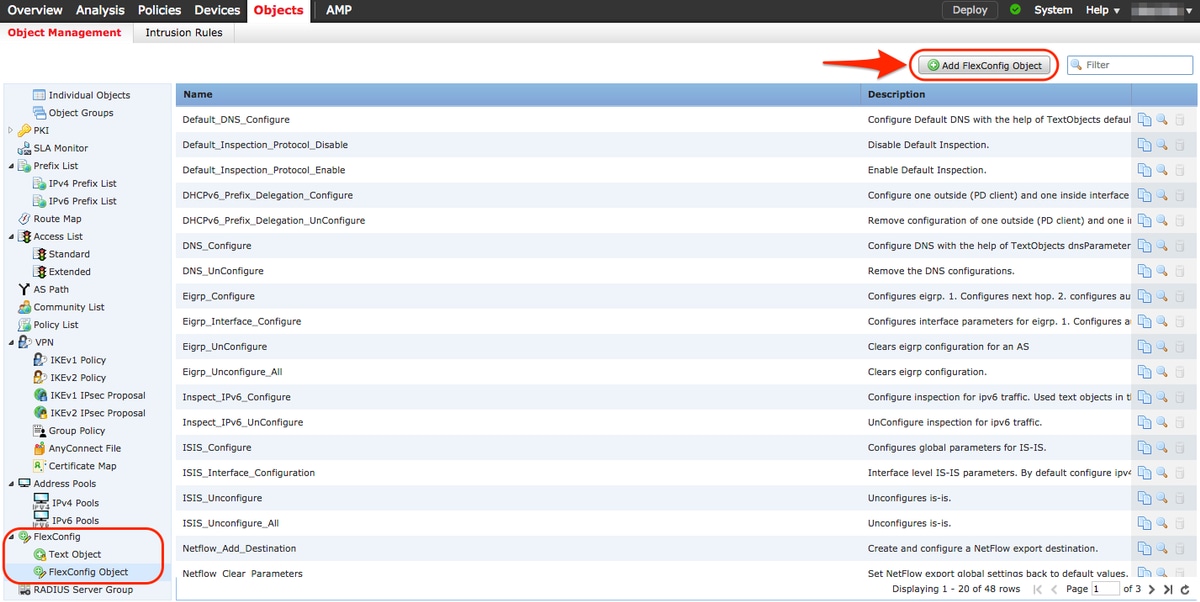
The name of the object for this example is called TCP_Bypass just as the Access List. This name doesn't need to match the Access List name.
Select Insert Policy Object > Extended ACL Object.
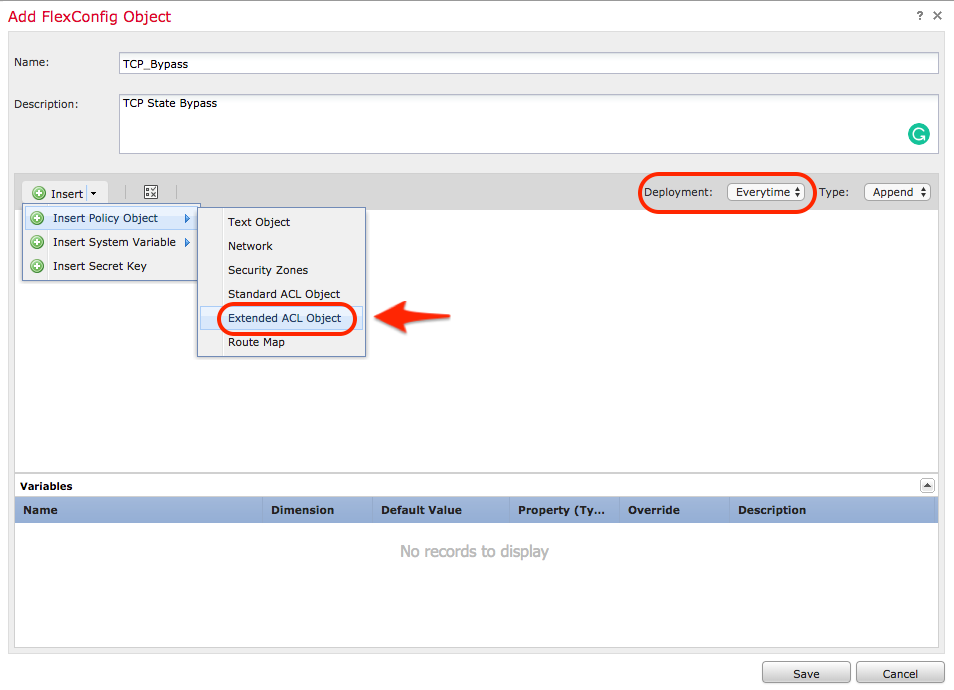
Note: Make sure to choose the "Everytime" option. This allows for preserving this configuration during other deployments and upgrades.
Select the Access List created in Step 1 from the Available Objects section and assign a Variable Name. Then, click on Add button. In this example, the Variable Name is TCP_Bypass.
Click on Save.
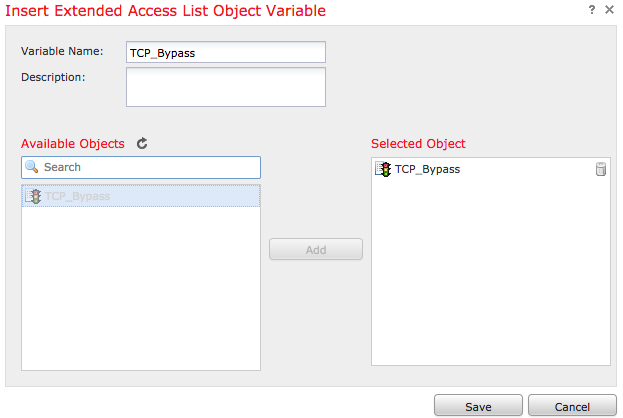
Add the next configuration lines in the blank field right below the Insert button and include the variable previously defined ($TCP_Bypass) in the match access-list configuration line. Note that a $ symbol is prepended to the variable name. This helps define that a variable follows after it.
class-map tcp_bypass
match access-list $TCP_Bypass
policy-map tcp_bypass_policy
class tcp_bypass
set connection advanced-options tcp-state-bypass
service-policy tcp_bypass_policy interface outside
In this example, a policy-map is created and it is applied to the outside interface. If TCP State Bypass requires to be configured as part of the global service policy, the tcp_bypass class map can be applied to global_policy.
Click on Save when finished.
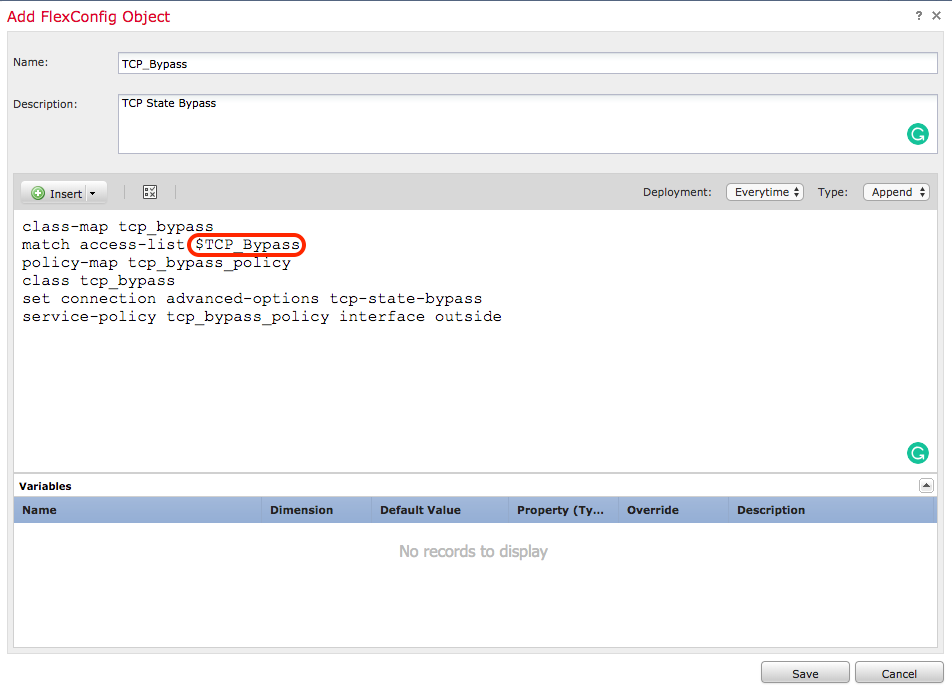
Step 3. Assign a FlexConfig Policy to the FTD
Go to Devices > FlexConfig and create a new policy (unless there is already one created for another purpose and assigned to the same FTD).In this example, the new FelxConfig policy is called TCP_Bypass.

Assign the TCP_Bypass FlexConfig policy to the FTD device.
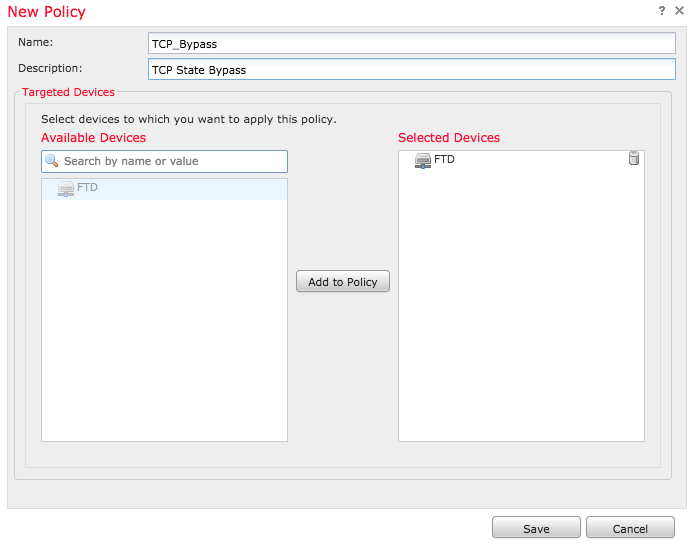
Select the FlexConfig Object called TCP_Bypass created in Step 2 under the User Defined section and click on the arrow to add that object to the policy.
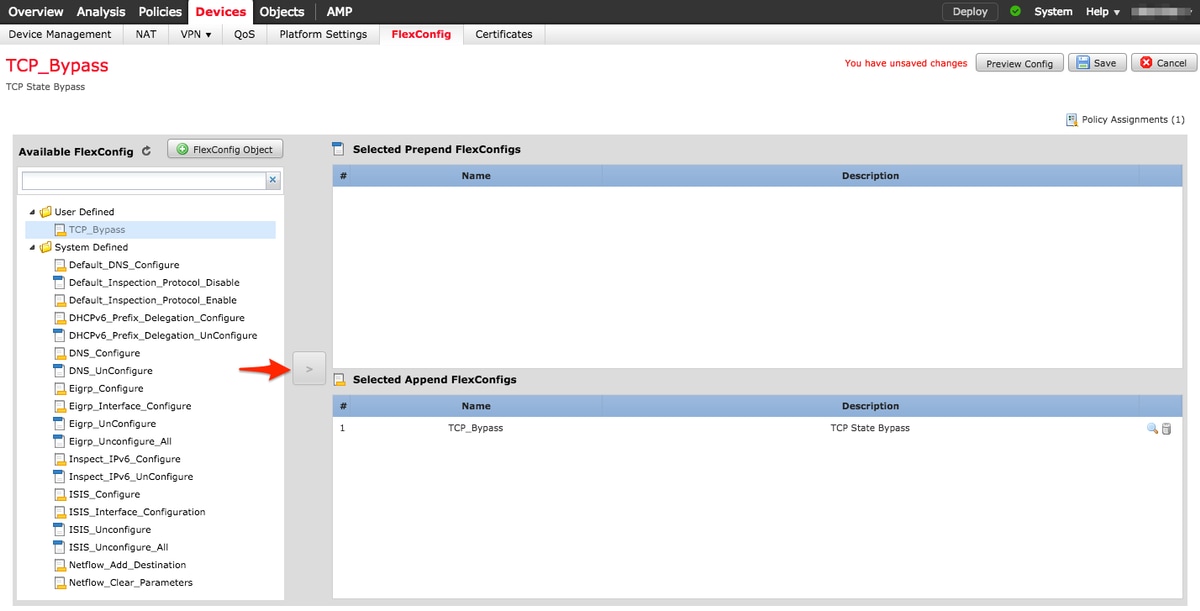
Save the changes and deploy,
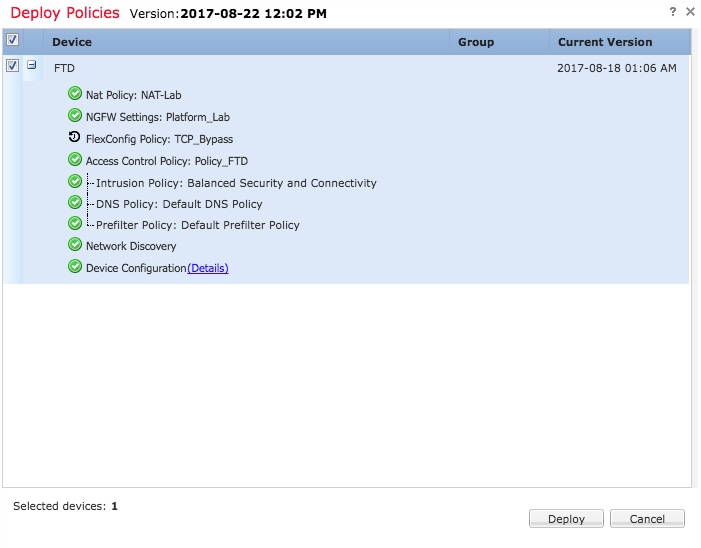
Verification
Access the FTD through SSH or console and use the command system support diagnostic-cli.
> system support diagnostic-cli
Attaching to Diagnostic CLI ... Press 'Ctrl+a then d' to detach.
Type help or '?' for a list of available commands.
firepower# show access-list TCP_Bypass
access-list TCP_Bypass; 1 elements; name hash: 0xec2b41eb
access-list TCP_Bypass line 1 extended permit object-group ProxySG_ExtendedACL_34359739205 object Host1 object Host2 log informational interval 300 (hitcnt=0) 0x42940b0e
access-list TCP_Bypass line 1 extended permit ip host 1.1.1.1 host 1.1.1.2 log informational interval 300 (hitcnt=0) 0x769561fc
firepower# show running-config class-map
!
class-map inspection_default
match default-inspection-traffic
class-map tcp_bypass
match access-list TCP_Bypass
!
firepower# show running-config policy-map
!
policy-map type inspect dns preset_dns_map
parameters
message-length maximum client auto
message-length maximum 512
no tcp-inspection
policy-map type inspect ip-options UM_STATIC_IP_OPTIONS_MAP
parameters
eool action allow
nop action allow
router-alert action allow
policy-map global_policy
class inspection_default
inspect dns preset_dns_map
inspect ftp
inspect h323 h225
inspect h323 ras
inspect rsh
inspect rtsp
inspect sqlnet
inspect skinny
inspect sunrpc
inspect xdmcp
inspect sip
inspect netbios
inspect tftp
inspect icmp
inspect icmp error
inspect ip-options UM_STATIC_IP_OPTIONS_MAP
class class-default
set connection advanced-options UM_STATIC_TCP_MAP
policy-map tcp_bypass_policy
class tcp_bypass
set connection advanced-options tcp-state-bypass
!
Troubleshoot
To troubleshoot this feature, these commands result in helpful.
- show conn [detail]
Shows connection information. Detailed information uses flags to indicate special connection characteristics.
For example, the “b” flag indicates traffic subject to TCP State Bypass
- show service-policy
Shows service policy statistics, including Dead Connection Detection (DCD) statistics
Related Links
https://www.cisco.com/c/en/us/td/docs/security/asa/asa91/configuration/firewall/asa_91_firewall_config/conns_connlimits.html
https://www.cisco.com/c/en/us/support/docs/security/asa-5500-x-series-next-generation-firewalls/118995-configure-asa-00.html
https://www.cisco.com/c/en/us/td/docs/security/firepower/620/configuration/guide/fpmc-config-guide-v62/flexconfig_policies.html